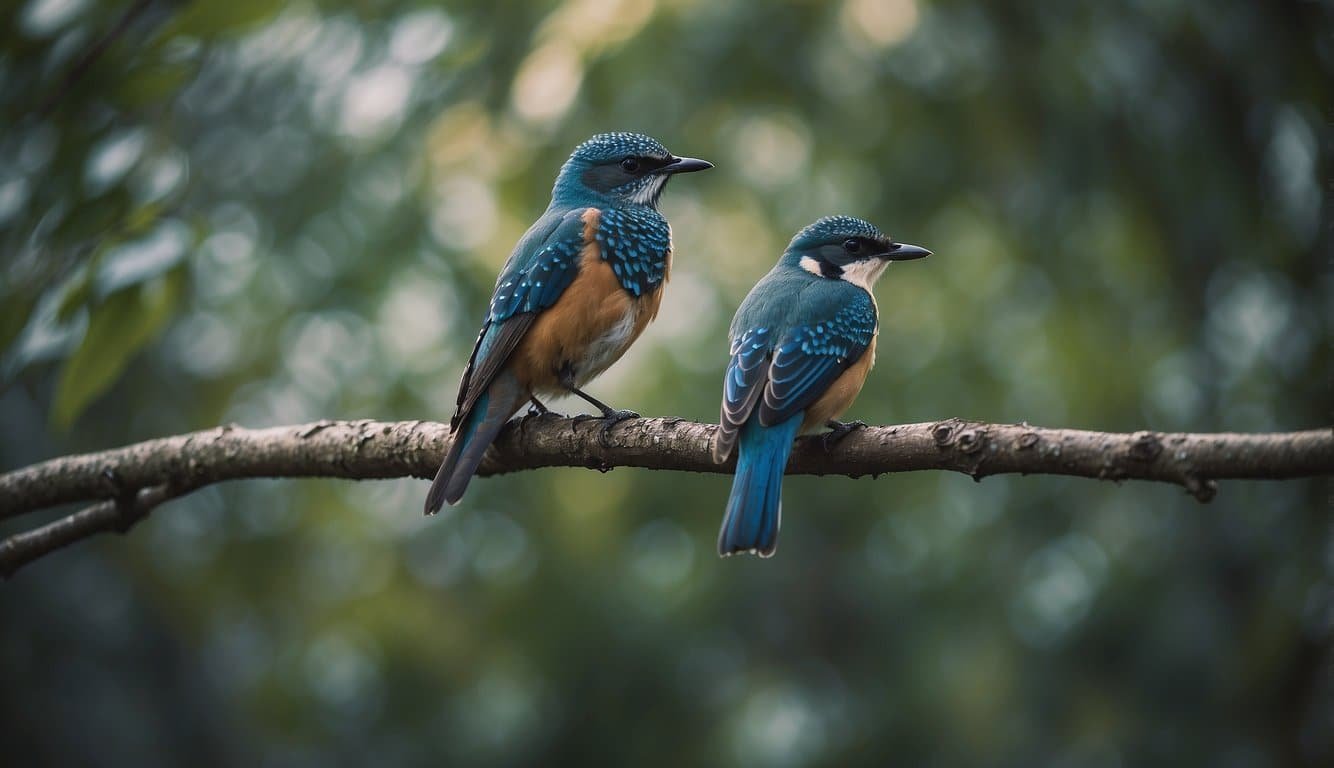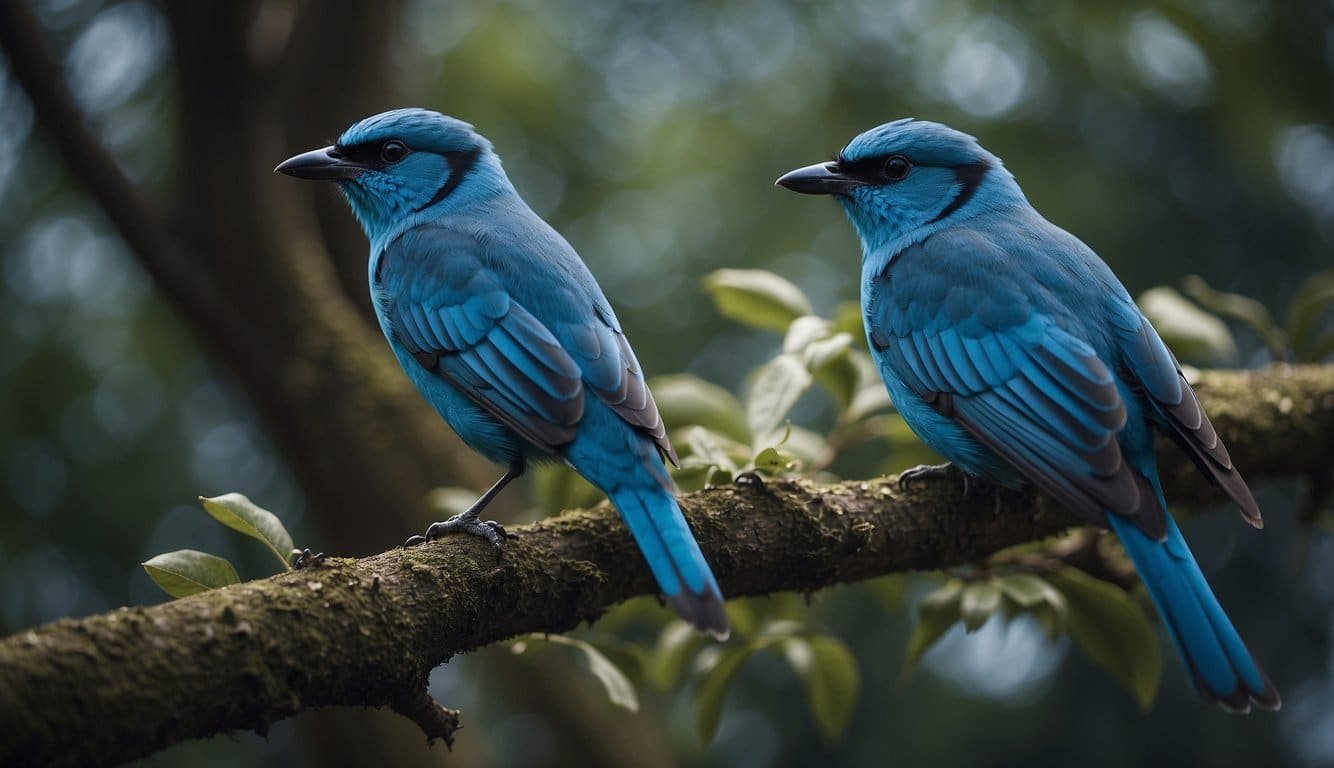Characteristics of Birds with Blue Wings
Birds with blue wings exhibit a dazzling array of hues, ranging from the deep ocean blues to sky-like tints. This section explores their striking features, from physical characteristics to behavioral patterns, and from their varied habitats to the nuances of identification.
Physical Description
Birds that sport blue wings often have a range of other plumage colors, but it is the blue that tends to stand out. The indigo bunting, for example, flaunts a brilliant cerulean during the breeding season. Sizes vary, with wingspans that can be impressively wide, like the great blue heron’s six-foot stretch.
Notable Species
Among the notable blue-winged species are the eastern bluebird, western bluebird, and the mountain bluebird, all of which are admired for their vibrant blue coloration. The blue jay is another recognizable species with its bright blue plumage and raucous calls.
Behavioral Traits
Blue-winged birds display a variety of behaviors, from the acrobatic flights of the blue-gray gnatcatcher to the jubilant songs of bluebirds. The birds’ lively antics are often audible before they are visible.
Habitat and Distribution
These birds can be found across different habitats, from the meadows preferred by bluebirds to the wetland domains of the little blue heron. North America is home to many blue-winged species, but some, like the blue-and-yellow macaws, can be found in South America.
Seasonal Movements
Migration patterns of blue-winged birds vary by species. For instance, bluebirds may migrate short distances in search of warmer climates, while others, such as the masked lovebird, do not migrate at all.
Conservation Status
Conservation statuses range widely among these avian beauties. While many species are stable, others like the cerulean warbler are considered threatened species, facing habitat loss and declining numbers.
Identification Tips
To correctly identify blue-winged birds, take note of specific features such as tail length, bill shape, and color pattern. The Merlin Bird ID app can be a helpful tool for enthusiasts trying to distinguish between similar species.
Interactions with Humans
Humans have long been fascinated by these blue-winged birds, building nest boxes to attract bluebirds or enjoying the glossy feathers of blue jays in backyards. These interactions often inspire a sense of wonder and imagination.
Comparisons and Confusion Species
Comparing similar species takes a keen eye, as features like the length and shape of the wings or tail can be subtly distinct. For example, comparing the California scrub-jay to other blue-winged birds requires noting the stark contrasts in their plumage patterns.
Reproduction and Life Cycle
The reproductive habits of these birds vary, with many species, like bluebirds, opting for cavities to nest. The average clutch size can differ dramatically, affecting the life history and survival of the young. In general, they tend to lay eggs once a year and are diligent in care for their nestlings.
Observing and Studying Blue-Winged Birds

The allure of blue-winged birds draws both casual bird watchers and dedicated ornithologists. Their vibrant hues and serene habitats provide a splendid spectacle and a rich subject for detailed study.
Bird Watching Essentials
For enthusiasts eager to observe these birds, a pair of binoculars and a field guide are indispensable. The guide often includes detailed illustrations for identification, accompanied by maps of habitats and measurements for size comparison. Birders learn to listen for the birds’ distinct sounds, which can lead to a visual encounter with these avian wonders.
Photography and Recording
Capturing the beauty of blue-winged birds requires patience. High-quality cameras with zoom lenses allow photographers to create a stunning photo gallery. Recording devices used to capture the birds’ calls complement the visual records and are integral for field studies, providing both inspiration and vital data for research.
Scientific Research and Data
Scientific field studies concentrate on understanding blue-winged birds in their natural environment. Researchers use habitat mapping and population surveys to assess conservation needs. They record birds’ behaviors and songs, often sharing their findings in videos and scholarly articles. The birds’ scientific names are used in academic journals to ensure clarity and precision in the global scientific community.
Bird watching essentials like binoculars and field guides assist in the identification and enjoyment of these birds’ natural habitats. Photography tools enable the creation of captivating photo galleries, while recordings of bird sounds contribute to scientific research and offer inspiration.
Cultural Significance and Symbolism

Birds with blue wings often carry profound symbolism across various cultures around the world. They can be a fountain of inspiration and stir the imagination with their vivid colors and graceful flight.
-
Inspiration: Artists and writers frequently draw inspiration from blue-winged birds. Their sky-blue plumage is likened to the limitless sky and open seas, symbolizing freedom and the urge to explore beyond the horizon.
-
Imagination: The striking appearance of these birds fuels stories and myths. For example, in some Native American cultures, blue-winged birds are believed to possess healing powers and are seen as messengers from the spiritual world.
The blue color itself carries significant meaning. It’s often associated with tranquility, depth, and wisdom. In the art and tapestry of storytelling, blue-winged birds symbolize these qualities, evoking a sense of peace and enlightenment. Most intriguingly, such birds are not mere figments of tales but do indeed exist in nature, with species like the blue jay being prominent in North American folklore.
In literature and the collective human imagination, birds with blue wings are sometimes depicted as carriers or guardians of secrets. They are ambassadors that ferry between the known and the unknown. This imagery has percolated through times, comfortably nesting in the pages of contemporary stories and poems alike.
Birds with blue wings continue to captivate individuals, inviting them on a journey through their beautiful and mysterious world. Through their presence, both in the wild and in the ethos of human culture, these avian wonders remind people of the beauty that flies above, often overlooked in the bustle of daily life.

